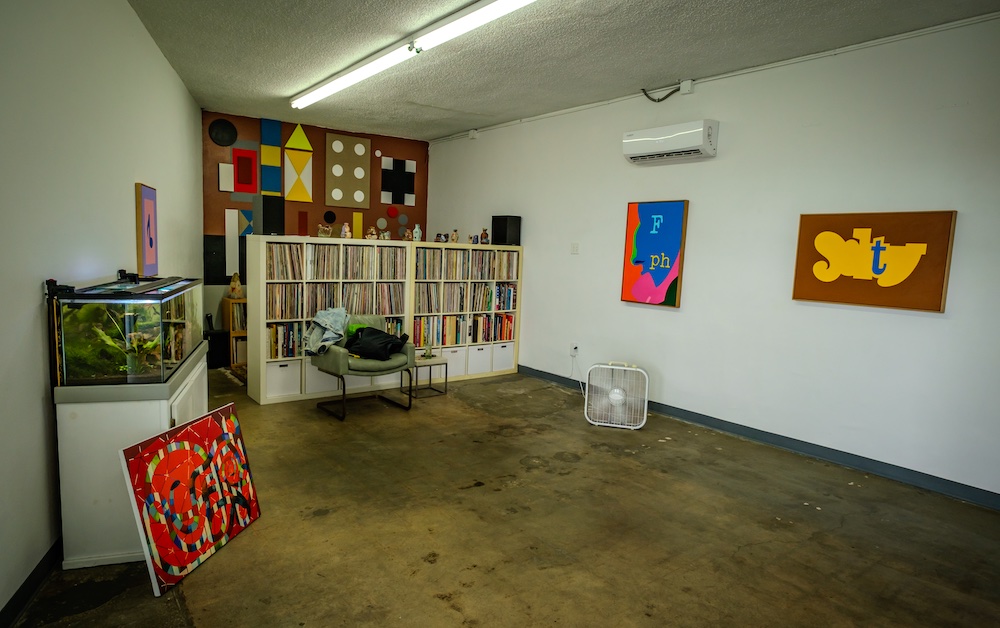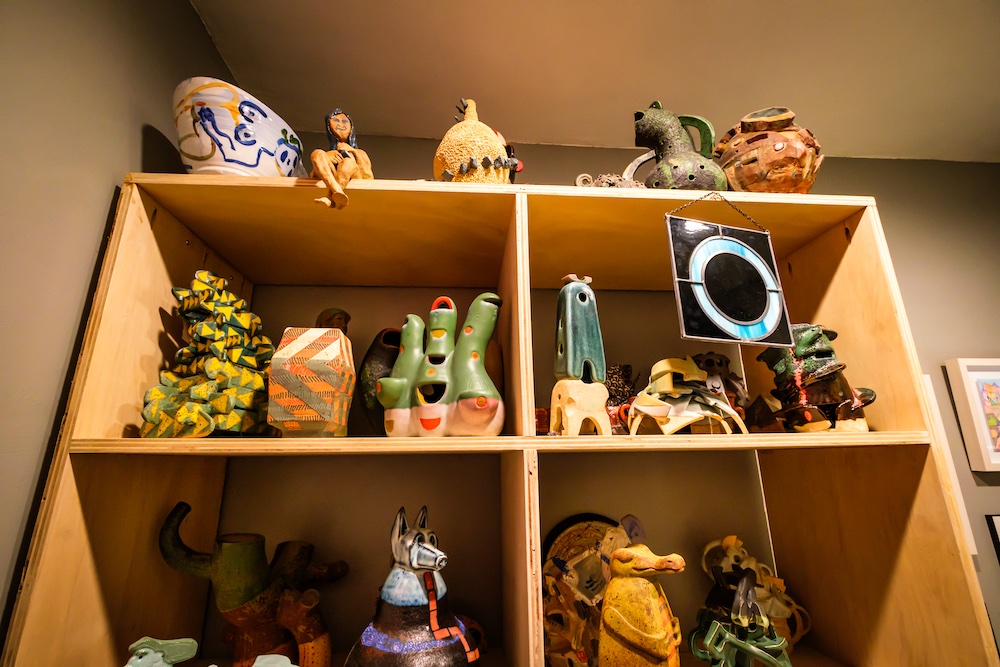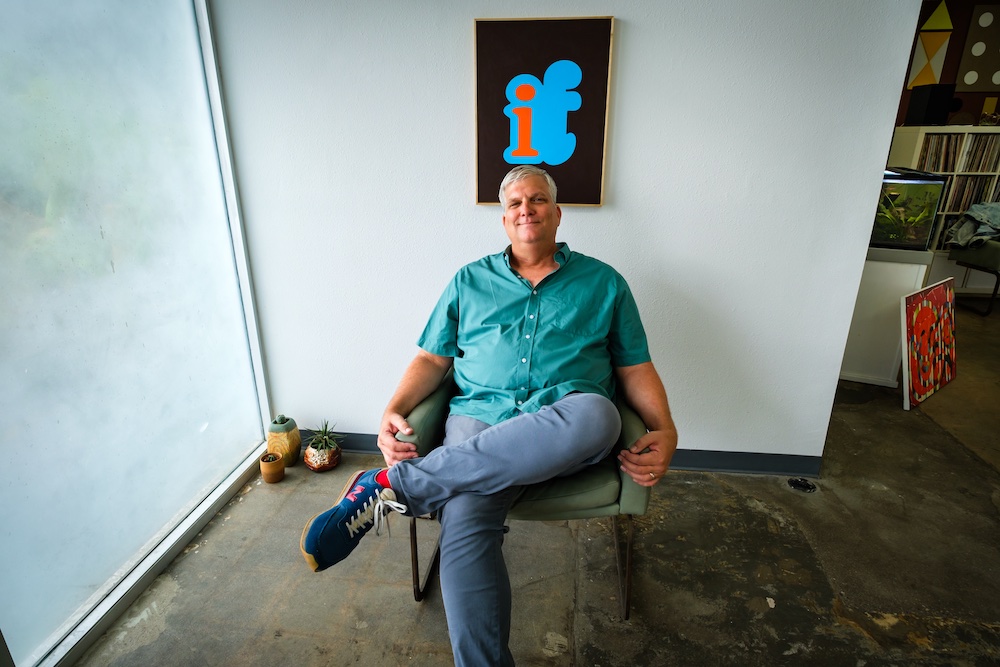“Well, there were many creatures in the cave. And some of them had their problems, but all of them, they were my friends….You don’t meet friends like this every day, so I’m staying in the cave.” —Wounded Lion, “Creatures in the Cave”
I first met Brad Eberhard earlier this year when I agreed at the last minute to fill in as a DJ at an opening at Alto Beta, the art space he started in March 2022. Tucked into an Altadena strip mall between a pizza joint and performance venue, PDA (Public Displays of Altadena), Alto Beta houses a scrappy, DIY ethos within a crisp, white box format. The interior of the modest one-room gallery is bounded on one side by a large bookshelf containing hundreds of vinyl records, representing the twin poles of Eberhard’s creative life: art and music. Behind the wall of LP’s sits the makeshift DJ booth, and openings feature various cultural luminaries spinning records. A tabletop aquarium, dubbed “Aqua Beta”, serves as a kind of mini-project space, where artists — including Alice Könitz, Ric Heitzman and Nicole Belle — have created backdrops for a school of tropical freshwater fish.
Although I only met Eberhard recently, I first encountered him about 15 years ago on stage with his band Wounded Lion, an art-tinged rock group that mixed a driving rhythmic thump with thick, fuzzed-out guitar, over which his quirky, almost child-like lyrics danced. Eberhard, with his collared shirt, kempt hair and gentle giant stature made for an unlikely frontman, a bit like a young David Byrne before the big suits. Though it could not be considered strictly a party band, Wounded Lion always seemed more concerned with having fun than being cool, which in itself was pretty cool. Art and music also mingled in Wounded Lion, which included artists Ami Tallman and Raffi Kalenderian as members. Future art star Jonas Wood designed an early show flier, while Brian Bress directed the hypnotic video for the song “Pony People.”
“I wanted to have a band with people that were really interesting rather than people who were musicians. Those people happened to be mostly artists,” Eberhard explained. “Not unlike Alto Beta, it wasn’t designed to succeed. It was conceived for fun. It was an experiment and it worked.” (His current band, Weird Symbol, is an angular, synth-driven project featuring former WL bandmate Jun Ohnuki, Eric Landmark (Numbers), and painter Liz Walsh.)

Alto Beta Interior, 2024. Photo: Bob Coulter.
From his work with Wounded Lion, I gained an impression of an artist focused more on discovery and camaraderie than critical or monetary success. That same punk spirit — of throwing it against the wall and seeing what sticks — is evident at Alto Beta, which Eberhard opened after a shift to ceramics in his practice left his painting studio available. “My rent is good, and I didn’t want to let go of the space. It was just kind of a lark. It was not extremely thought out,” he explained. “At first I thought I’d do it for a year and call it quits, but the crowd response has been really superb.”
Lark or not, Eberhard set out with a clear mandate: to showcase overlooked and underappreciated artists—those who haven’t had solo shows yet, or who haven’t exhibited in LA for three to five years; ceramic artists who only tangentially rub up against the “fine art” world, and those in what he
describes as the “desert of being a mid-career artist.”
“I know a lot of artists that aren’t presently connected with the commercial gallery system who make great work, and so I just started asking people,” Eberhard said. He opened with a show of loose abstractions by painter Heather Brown, and subsequent exhibitions have included Lorraine Heitzman’s found-object assemblages, Tim Powers’ pop-inflected riffs on language and pop culture, and expressionistic canvases by alt-theater dynamo Asher Hartman.
Guest DJs have ranged from underground music icon Ian Svenonius (The Nation of Ulysses, The Make-Up, Escape-ism) who showed up with a suitcase of early ‘60s soul and R’n’B 45s, writer Jan Tumlir, who stuck exclusively to the Factory Records label, and Hedi El Kholti, co-editor of Semiotext(e), whose film-soundtrack-heavy DJ set accompanied artist Carter Potter’s film leader constructions. “Sometimes there’s a conceptual connection,” Eberhard explained. “Some people just play good time rock’n’roll.”
“I like the cross-pollination,” he said. “I’ve been to so many art openings that feel kind of staid. It just felt like there’s got to be a better way to do it, a way that’s more enjoyable, and loose.”

Bookshelf at Alto Beta, 2024. Photo: Bob Coulter.
His own visual practice also embraces trial and error, often combining unconventional mediums and subjects. Eberhard uses the term “mutant formalism” to describe his paintings, which mingle recognizable elements with abstract patterns. His ceramics draw on art-historical references from ancient Egypt to mid-century modernism, mixed with his own idiosyncratic take on shape and color. The intimate scale of both his paintings and sculptures give them an approachable air, inviting viewers to ponder their oddity. He counts as a mentor the late artist Steve Roden, and the two share an interest in the balance between experimentation and order, not to mention sound and vision.
Eberhard’s sensibility is native Californian: he grew up in Orange County, even working at Disneyland as a teen. He first moved to the area around Alto Beta more than 30 years ago, and notes that Culver City, Chinatown or East Hollywood may be more closely associated with the LA art scene, Altadena has long been home to scores of artists, who have chosen that corner of LA County precisely for its distance from the center.
As more cultural and financial capital flows into LA, there is genuine concern that artists — those whose labor creates the art industry — may be forced to move further and further out. He acknowledges this potential threat but is still hopeful about the aspects of LA that make creative communities here possible.
“It’s a city the size of a country. I would hope everyone could find their people here and that, whatever you’re into, you could find enough people to support your weird band or your artistic point of view, or your artist-run space that’s kind of focused on poetic, ineffable work,” said Eberhard with a laugh. “It’s all I’ve known. I’m a third-generation Southern Californian. My network is here, for art and for music. I can’t really picture leaving that.”


